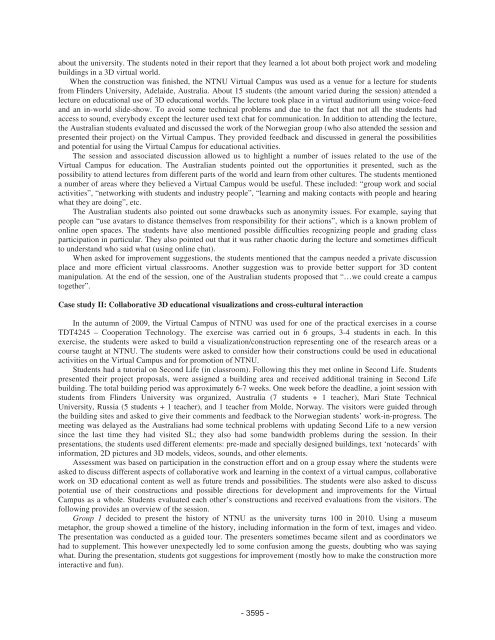Disputation Mikhail Fominykh - Department of Computer and ...
Disputation Mikhail Fominykh - Department of Computer and ...
Disputation Mikhail Fominykh - Department of Computer and ...
You also want an ePaper? Increase the reach of your titles
YUMPU automatically turns print PDFs into web optimized ePapers that Google loves.
about the university. The students noted in their report that they learned a lot about both project work <strong>and</strong> modeling<br />
buildings in a 3D virtual world.<br />
When the construction was finished, the NTNU Virtual Campus was used as a venue for a lecture for students<br />
from Flinders University, Adelaide, Australia. About 15 students (the amount varied during the session) attended a<br />
lecture on educational use <strong>of</strong> 3D educational worlds. The lecture took place in a virtual auditorium using voice-feed<br />
<strong>and</strong> an in-world slide-show. To avoid some technical problems <strong>and</strong> due to the fact that not all the students had<br />
access to sound, everybody except the lecturer used text chat for communication. In addition to attending the lecture,<br />
the Australian students evaluated <strong>and</strong> discussed the work <strong>of</strong> the Norwegian group (who also attended the session <strong>and</strong><br />
presented their project) on the Virtual Campus. They provided feedback <strong>and</strong> discussed in general the possibilities<br />
<strong>and</strong> potential for using the Virtual Campus for educational activities.<br />
The session <strong>and</strong> associated discussion allowed us to highlight a number <strong>of</strong> issues related to the use <strong>of</strong> the<br />
Virtual Campus for education. The Australian students pointed out the opportunities it presented, such as the<br />
possibility to attend lectures from different parts <strong>of</strong> the world <strong>and</strong> learn from other cultures. The students mentioned<br />
a number <strong>of</strong> areas where they believed a Virtual Campus would be useful. These included: “group work <strong>and</strong> social<br />
activities”, “networking with students <strong>and</strong> industry people”, “learning <strong>and</strong> making contacts with people <strong>and</strong> hearing<br />
what they are doing”, etc.<br />
The Australian students also pointed out some drawbacks such as anonymity issues. For example, saying that<br />
people can “use avatars to distance themselves from responsibility for their actions”, which is a known problem <strong>of</strong><br />
online open spaces. The students have also mentioned possible difficulties recognizing people <strong>and</strong> grading class<br />
participation in particular. They also pointed out that it was rather chaotic during the lecture <strong>and</strong> sometimes difficult<br />
to underst<strong>and</strong> who said what (using online chat).<br />
When asked for improvement suggestions, the students mentioned that the campus needed a private discussion<br />
place <strong>and</strong> more efficient virtual classrooms. Another suggestion was to provide better support for 3D content<br />
manipulation. At the end <strong>of</strong> the session, one <strong>of</strong> the Australian students proposed that “…we could create a campus<br />
together”.<br />
Case study II: Collaborative 3D educational visualizations <strong>and</strong> cross-cultural interaction<br />
In the autumn <strong>of</strong> 2009, the Virtual Campus <strong>of</strong> NTNU was used for one <strong>of</strong> the practical exercises in a course<br />
TDT4245 – Cooperation Technology. The exercise was carried out in 6 groups, 3-4 students in each. In this<br />
exercise, the students were asked to build a visualization/construction representing one <strong>of</strong> the research areas or a<br />
course taught at NTNU. The students were asked to consider how their constructions could be used in educational<br />
activities on the Virtual Campus <strong>and</strong> for promotion <strong>of</strong> NTNU.<br />
Students had a tutorial on Second Life (in classroom). Following this they met online in Second Life. Students<br />
presented their project proposals, were assigned a building area <strong>and</strong> received additional training in Second Life<br />
building. The total building period was approximately 6-7 weeks. One week before the deadline, a joint session with<br />
students from Flinders University was organized, Australia (7 students + 1 teacher), Mari State Technical<br />
University, Russia (5 students + 1 teacher), <strong>and</strong> 1 teacher from Molde, Norway. The visitors were guided through<br />
the building sites <strong>and</strong> asked to give their comments <strong>and</strong> feedback to the Norwegian students’ work-in-progress. The<br />
meeting was delayed as the Australians had some technical problems with updating Second Life to a new version<br />
since the last time they had visited SL; they also had some b<strong>and</strong>width problems during the session. In their<br />
presentations, the students used different elements: pre-made <strong>and</strong> specially designed buildings, text ‘notecards’ with<br />
information, 2D pictures <strong>and</strong> 3D models, videos, sounds, <strong>and</strong> other elements.<br />
Assessment was based on participation in the construction effort <strong>and</strong> on a group essay where the students were<br />
asked to discuss different aspects <strong>of</strong> collaborative work <strong>and</strong> learning in the context <strong>of</strong> a virtual campus, collaborative<br />
work on 3D educational content as well as future trends <strong>and</strong> possibilities. The students were also asked to discuss<br />
potential use <strong>of</strong> their constructions <strong>and</strong> possible directions for development <strong>and</strong> improvements for the Virtual<br />
Campus as a whole. Students evaluated each other’s constructions <strong>and</strong> received evaluations from the visitors. The<br />
following provides an overview <strong>of</strong> the session.<br />
Group 1 decided to present the history <strong>of</strong> NTNU as the university turns 100 in 2010. Using a museum<br />
metaphor, the group showed a timeline <strong>of</strong> the history, including information in the form <strong>of</strong> text, images <strong>and</strong> video.<br />
The presentation was conducted as a guided tour. The presenters sometimes became silent <strong>and</strong> as coordinators we<br />
had to supplement. This however unexpectedly led to some confusion among the guests, doubting who was saying<br />
what. During the presentation, students got suggestions for improvement (mostly how to make the construction more<br />
interactive <strong>and</strong> fun).<br />
- 3595 -
















